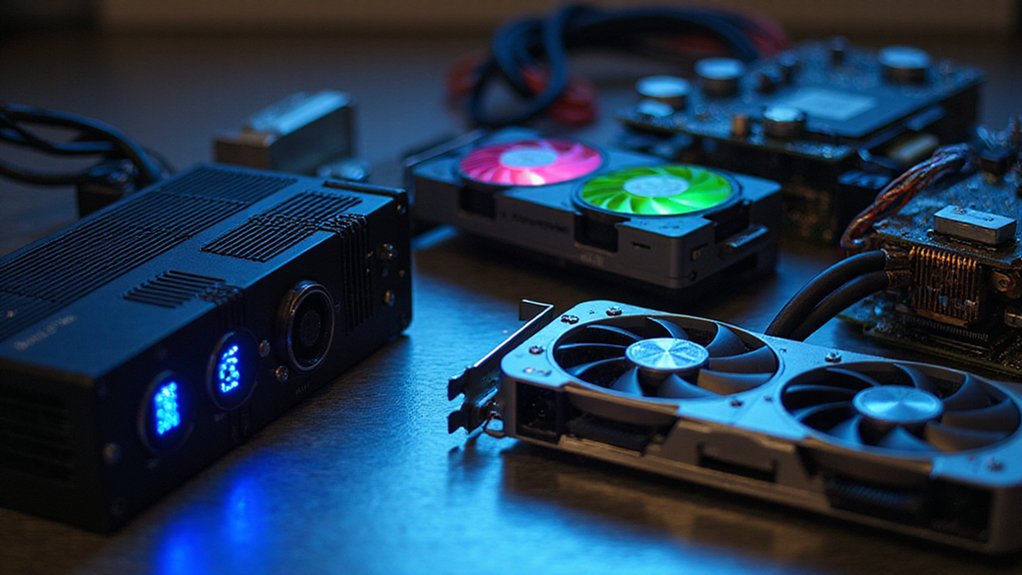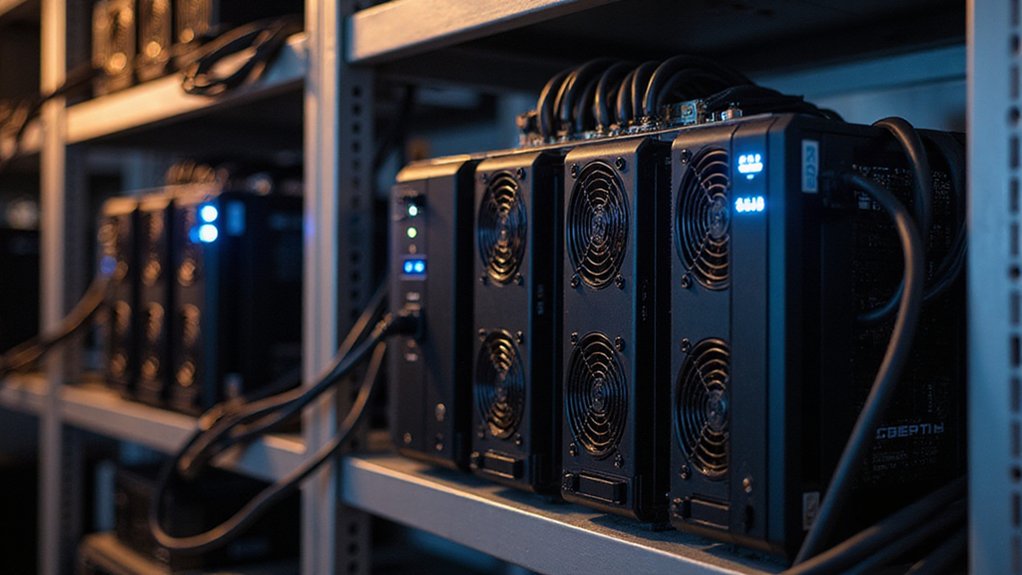BFGMiner represents a modular, command-line cryptocurrency mining software that eschews user-friendly interfaces in favor of raw functionality, enabling experienced miners to simultaneously operate ASIC devices, FPGA boards, GPUs, and CPUs across multiple blockchain networks. This open-source application provides dynamic clocking, temperature monitoring, and overclocking capabilities while supporting various algorithms including Scrypt and SHA protocols. The software’s hardware-agnostic approach allows strategic diversification across different cryptocurrencies, though its Unix-style complexity rewards technical proficiency with unprecedented operational control.

In the labyrinthine world of cryptocurrency mining—where fortunes are made and electricity bills soar in equal measure—BFGMiner stands as a demonstration to what happens when developers prioritize functionality over flashy interfaces. This modular mining software, written in C programming language, represents the epitome of utilitarian design: a command-line interface that would make a Unix administrator weep with joy while sending GUI-dependent users scrambling for YouTube tutorials.
BFGMiner’s architecture embraces hardware agnosticism with the fervor of a Swiss banker maintaining neutrality. The software simultaneously supports ASIC miners, FPGA boards, GPUs, and CPUs within a single framework—a feat roughly equivalent to conducting a symphony orchestra where each section plays different compositions yet somehow produces harmonious results. This multi-threaded architecture maximizes mining efficiency across diverse hardware configurations, allowing operators to squeeze every hash from their silicon investments.
The software’s multi-currency capabilities deserve particular attention, enabling simultaneous mining of various cryptocurrencies through different algorithms including Scrypt and SHA family protocols. Rather than limiting users to Bitcoin’s increasingly competitive SHA-256 landscape, BFGMiner facilitates strategic diversification across multiple blockchain networks—because why put all your computational eggs in one cryptographic basket? At its core, the software enables miners to solve cryptographic puzzles that require substantial computational power to validate transactions and secure the blockchain network.
Advanced miners particularly appreciate BFGMiner’s granular control mechanisms: dynamic clocking, temperature monitoring, fan speed management, and overclocking capabilities that transform standard hardware into profit-optimized workhorses. The software’s comprehensive monitoring extends to critical miner statistics including temperature readings, hashrate performance, fan speed control, and average processing speeds. The remote interface functionality proves invaluable for managing distributed mining operations, though one might question the wisdom of overclocking expensive hardware to chase increasingly marginal returns.
Cross-platform compatibility spanning Windows, Linux, and MacOS ensures broad deployment flexibility, with the rather amusing capability of running on OpenWrt-capable routers—transforming household networking equipment into miniature mining operations. This adaptability extends to professional mining farms where BFGMiner manages multiple rigs simultaneously, tracking performance metrics and mining rewards with accounting precision. The comprehensive mining statistics include bandwidth usage calculations where efficiency is measured as the accepted shares per 2 KB of bandwidth consumed.
As open-source software hosted on GitHub with over 90 contributors, BFGMiner embodies the collaborative spirit that theoretically underpins cryptocurrency philosophy. The absence of licensing fees represents a revitalizing departure from software vendors who extract recurring revenue while users assume all operational risks.
For advanced miners seeking thorough control over their digital treasure hunts, BFGMiner delivers functionality that prioritizes substance over style—assuming they possess sufficient technical fortitude to harness its capabilities.
Frequently Asked Questions
Is BFGMINER Compatible With Windows, Mac, and Linux Operating Systems?
BFGMiner demonstrates the familiar pattern of open-source mining software: robust Windows and Linux compatibility with Mac users left contemplating virtualization workarounds.
While Windows users enjoy optimized performance and Linux enthusiasts access advanced configurations, Mac compatibility remains theoretically possible yet practically unsupported—requiring technical gymnastics that most miners would rather avoid.
The cross-platform promise delivers selectively, reflecting cryptocurrency software’s pragmatic focus on platforms where serious mining actually occurs.
How Much Electricity Does BFGMINER Consume During Cryptocurrency Mining Operations?
BFGMiner itself consumes negligible electricity—it’s merely software orchestrating the real power-hungry culprits: the mining hardware.
The actual consumption depends entirely on deployed ASIC models, which can range from modest kilowatts to industrial-scale megawatts.
Modern setups often draw 3,000-7,000 watts per mining rig, translating to roughly $2,000-5,000 annually in electricity costs at average U.S. rates—assuming one’s hardware doesn’t become paperweights first.
Can BFGMINER Be Used to Mine Multiple Cryptocurrencies Simultaneously?
BFGMiner’s modular architecture enables simultaneous multi-cryptocurrency mining through concurrent algorithm support—SHA256d, Scrypt, and others—across diverse hardware configurations.
Its multi-threaded design handles separate work retrievals and submissions without significant resource strain, while dynamic intensity adjustments optimize performance.
The software manages multiple pools with intelligent failover mechanisms, allowing miners to diversify their operations efficiently.
This capability proves particularly valuable for maximizing hardware utilization across different blockchain networks simultaneously.
What Are the Minimum Hardware Requirements Needed to Run BFGMINER Effectively?
BFGMiner demands surprisingly modest baseline requirements: any multi-core CPU, 8GB RAM, and stable internet connectivity.
However, effective mining necessitates specialized hardware—powerful GPUs with 4GB+ memory, ASIC devices, or FPGA units. The software’s modular architecture accommodates various mining hardware configurations, though CPU-only mining yields laughably minimal returns.
Linux or Windows environments require specific development libraries (libcurl, libjansson, libusb) for proper compilation and hardware integration functionality.
Does BFGMINER Support GPU Mining or Only ASIC and FPGA Devices?
BFGMiner does support GPU mining through OpenCL-compatible graphics cards, though this capability represents something of an afterthought in its design philosophy.
The software’s modular architecture accommodates GPUs alongside its primary focus on ASIC and FPGA devices, enabling multi-algorithm mining including Scrypt.
However, its advanced features and optimization clearly favor specialized hardware—making GPU support functional yet decidedly secondary to its ASIC-centric mission.









